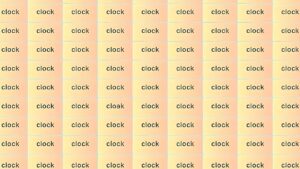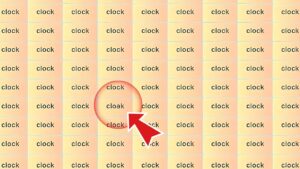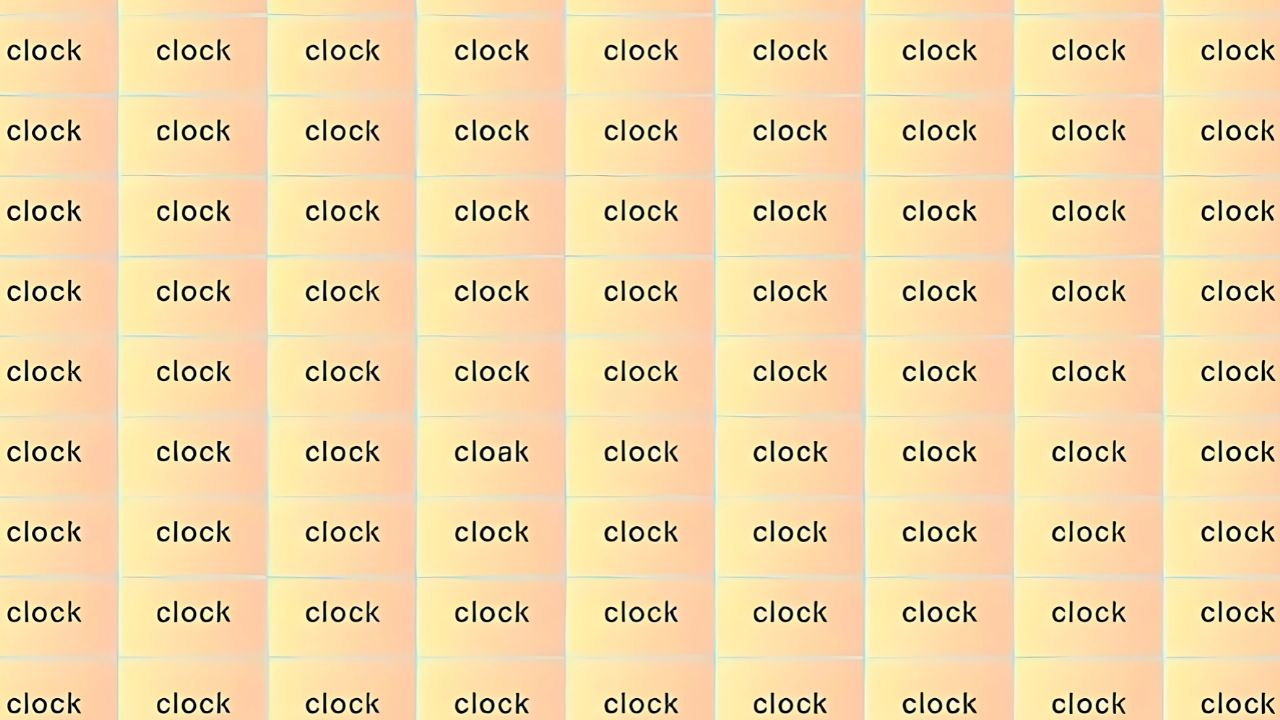Visual puzzles have taken social media by storm, and the latest optical illusion challenge is leaving millions scratching their heads. The task seems deceptively simple: locate the word “CLOAK” hidden among dozens of “CLOCK” words within just five seconds. Yet this seemingly straightforward puzzle reveals profound insights about human perception, cognitive processing, and the fascinating ways our brains interpret visual information.
Understanding the Psychology Behind This Viral Optical Illusion
When you first encounter this optical illusion, your brain immediately begins a complex process of pattern recognition and visual sorting. The human visual system, evolved over millions of years to quickly identify threats and opportunities in our environment, faces a unique challenge when confronted with nearly identical text patterns. This particular puzzle exploits a fundamental aspect of how we process written language – our tendency to read words as complete units rather than individual letters.

The substitution of a single letter transforms “CLOCK” into “CLOAK,” creating what psychologists call a “visual search task.” Your brain must overcome its natural inclination to categorize all similar-looking words as identical and instead focus on subtle differences that distinguish the target from distractors. This process becomes exponentially more difficult when time pressure is applied, forcing your visual system to rely on rapid, automatic processing rather than careful, deliberate analysis.
The Neuroscience of Pattern Recognition and Visual Processing
Research in cognitive neuroscience reveals that visual search tasks like this optical illusion activate multiple brain regions simultaneously. The fusiform word form area, located in the left hemisphere of the brain, specializes in recognizing written words and letter combinations. When searching for “CLOAK” among “CLOCK” instances, this region works intensively to distinguish between nearly identical letter patterns.
Your brain employs two distinct processing strategies: bottom-up and top-down processing. Bottom-up processing analyzes individual letters and builds toward word recognition, while top-down processing uses existing knowledge and expectations to quickly identify familiar patterns. Most people naturally rely on top-down processing, which explains why the dominant word “CLOCK” can effectively mask the presence of “CLOAK.”
Why Time Pressure Amplifies the Challenge
The five-second time constraint isn’t arbitrary – it’s specifically designed to test your brain’s automatic processing capabilities. Under time pressure, your visual system shifts into a mode that prioritizes speed over accuracy, relying heavily on rapid pattern recognition rather than methodical analysis. This creates the perfect conditions for overlooking subtle variations in an otherwise uniform visual field.
Consider the evolutionary perspective: our ancestors needed to quickly scan their environment for potential threats or food sources. This ability to rapidly categorize visual information as “relevant” or “irrelevant” was crucial for survival. However, this same system that once helped humans survive in the wild can be easily fooled by carefully constructed visual puzzles in our modern digital age.
Individual Differences in Optical Illusion Performance
Not everyone performs equally well on this type of optical illusion, and these differences reveal fascinating insights about cognitive diversity. Factors influencing performance include visual acuity, attention span, working memory capacity, and even personality traits such as patience and persistence. Some individuals naturally excel at detail-oriented tasks, while others are better suited for big-picture thinking.
Age also plays a significant role in visual search performance. Younger individuals often demonstrate faster processing speeds, while older adults may compensate with superior strategic approaches and greater persistence. Interestingly, people with certain learning differences, such as dyslexia, sometimes outperform neurotypical individuals on tasks requiring unconventional visual processing strategies.
Training Your Brain for Better Visual Search Skills
Regular engagement with optical illusions and visual puzzles can actually improve your performance over time. Your brain develops more efficient search strategies and becomes better at suppressing irrelevant information while focusing on task-relevant details. This cognitive flexibility training has real-world applications, benefiting activities ranging from reading and driving to professional tasks requiring meticulous attention to detail.
Systematic scanning techniques often prove more effective than random searching. Start from one corner of the image and work methodically across the visual field, rather than allowing your eyes to jump randomly from word to word. This approach reduces the likelihood of missing the target and provides a sense of progress and completion.
The Broader Category of Hidden Letter Challenges
The CLOAK-CLOCK puzzle represents just one example in a vast category of visual search tasks that researchers use to study attention and perception. These challenges can involve finding different letters, numbers, geometric shapes, or colors hidden within similar patterns. Each variation tests different aspects of visual processing and cognitive flexibility, providing insights into the remarkable capabilities and limitations of human perception.
Some puzzles focus on color discrimination, requiring you to identify subtle differences in hue or saturation. Others test shape recognition, asking you to locate geometric forms that differ slightly from surrounding distractors. Each type of optical illusion reveals different aspects of how our visual system processes and interprets information.
Practical Applications Beyond Entertainment
While these optical illusions provide entertainment and social media engagement, they also offer genuine cognitive benefits. Healthcare professionals increasingly incorporate similar exercises into cognitive rehabilitation programs for patients recovering from brain injuries or managing age-related cognitive changes. Regular practice with visual puzzles can help maintain sharp attention skills, improve concentration, and potentially slow cognitive decline.

Educational applications include training programs for professions requiring exceptional visual attention, such as air traffic control, medical diagnosis, and quality control inspection. The skills developed through these exercises transfer to real-world scenarios where the ability to quickly identify important details among irrelevant information can be crucial.
Advanced Strategies for Puzzle Solving Success
To maximize your success with this type of optical illusion, consider implementing several proven strategies. First, resist the urge to scan rapidly across the entire image. Instead, divide the visual field into manageable sections and examine each area thoroughly before moving on. This systematic approach prevents your brain from becoming overwhelmed by the sheer volume of similar information.
Second, try varying your scanning pattern. Some people perform better scanning horizontally, while others prefer vertical or diagonal approaches. Experiment with different methods to discover your personal optimal strategy. Third, take brief breaks if you find yourself struggling. Sometimes stepping away from the puzzle for a few seconds allows your visual system to reset and approach the challenge with fresh perspective.
Finally, practice patience and persistence. While the five-second time limit creates urgency, remember that the goal is ultimately to locate the hidden word, regardless of how long it takes. Many people become so focused on the time constraint that they sacrifice accuracy for speed, ultimately undermining their performance.
Frequently Asked Questions
Q: Is it normal if I can’t find the hidden word in 5 seconds? A: Absolutely! The 5-second timeframe is intentionally challenging. Most people need significantly longer to locate the target word, and there’s no shame in taking your time to solve the puzzle accurately.
Q: Do these optical illusions actually improve brain function? A: Research suggests that regular practice with visual puzzles can enhance attention to detail, improve concentration, and strengthen cognitive flexibility. However, these benefits are most pronounced when puzzles are used as part of a broader cognitive training program.
Q: Why do some people find these puzzles easier than others? A: Individual differences in visual processing speed, attention span, working memory, and prior experience with similar tasks all contribute to performance variations. Additionally, certain learning differences can sometimes provide advantages in unconventional visual processing tasks.
Q: Are there techniques to improve my performance on visual search tasks? A: Yes! Systematic scanning patterns, dividing the image into sections, varying your search strategy, and practicing patience all contribute to better performance. Regular practice with different types of visual puzzles also helps develop more efficient search strategies.
Q: How do time limits affect puzzle-solving performance? A: Time pressure typically reduces accuracy by forcing your brain to rely on rapid, automatic processing rather than careful analysis. While some people perform better under pressure, most benefit from removing time constraints to focus on systematic problem-solving approaches.
